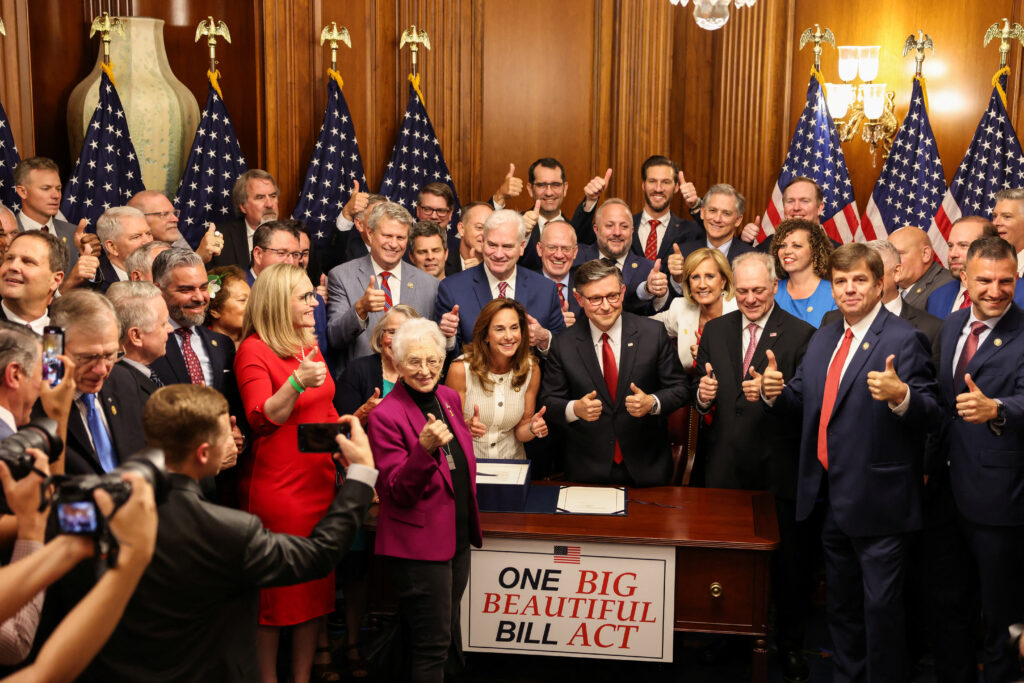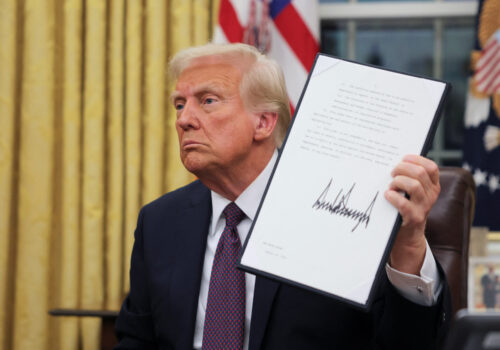The Republican legislative package known as the “big, beautiful bill” powered through Congress this week, with the House, then the Senate, then the House again passing it. It next heads to President Donald Trump’s desk for an expected Independence Day signing ceremony. During this process, the mega-legislation has seen several major provisions pertaining to US energy added, others removed, and some refined. To gauge where the bill stands in achieving Trump’s goal of US energy dominance, Atlantic Council Global Energy Center experts share two analyses below.
The bill sets a foundation, but one bill won’t be enough
Trump’s “big, beautiful bill” represents a pivotal moment for US energy policy. Rather than serving as a final word on American energy dominance, the legislation initiates a new dialogue in Washington, DC, about how the nation’s energy system should be recalibrated to prioritize energy security—emphasizing reliability, domestic capacity, and system integration.
As artificial intelligence–driven electricity demand threatens to eclipse 100 gigawatts and accelerate exponentially during Trump’s second term, the bill underscores the urgency many Republicans feel to bolster US generation with dependable, dispatchable resources. Within this framework, technologies such as natural gas, nuclear, and geothermal are not only strategic choices but also reflect the United States’ comparative advantages.
Notably, the legislation cements nuclear energy as a foundational element in the nation’s future energy mix. Years of incremental, bipartisan support have matured into formal policy momentum. By positioning nuclear as a central pillar, the United States joins a growing global consensus on its strategic value, particularly as energy systems become more complex.
This direction reflects a Republican policy view that ensuring reliable, affordable power in an era of artificial intelligence, electrification, and geopolitical competition requires anchoring national energy strategy in long-term physical and industrial resilience. That means investing in infrastructure capable of withstanding shocks and in a domestic industrial base strong enough to supply the technologies needed to sustain it. To that end, the legislation includes provisions aimed at limiting the use of Chinese-manufactured components in the US grid, reflecting heightened concern over foreign influence in critical energy systems. It also responds to perceived shortcomings in other advanced economies. Countries with aggressive renewable rollouts, such as Germany and the United Kingdom, have faced high energy costs and reliability challenges in part because of fragmented grid planning and complex system integration.
Still, the legislation is only a starting point. Congress faces unfinished work—chiefly, permitting reform. Without streamlined processes to support the build-out of transmission, advanced nuclear, gas infrastructure, and geothermal projects, the nation risks falling short of the very objectives this bill sets in motion.
In this sense, the megabill serves not as a capstone but as a foundation for the next era of US energy leadership. In a decade likely to be defined by soaring digital power demand and strategic competition with China, the real test is not whether the United States has selected the right tools, but whether it can deploy them at the speed and scale required. And for those left outside the immediate strategy—particularly solar and wind proponents—new opportunities to shape the country’s energy future are all but assured.
—Landon Derentz is vice president, energy and infrastructure, senior director and Morningstar Chair for Global Energy Security at the Atlantic Council Global Energy Center.
This bill is not the way to US energy dominance
The final version of the “big, beautiful bill” is likely to undermine the Trump administration’s goal of energy dominance.
First, by cutting short the tax preferences enshrined in the Inflation Reduction Act (IRA) before their prior legislative deadline in 2032—an extraordinary precedent that will unsettle investors—Congress has created uncertainty in the reliability of all energy tax preferences. Rather than stepping back on the US roller coaster, investors are much more likely to wait to see what the next election brings, at least through the midterms.
Second, the bill egregiously wastes the billions in commitments made for hydrogen, carbon capture, battery, wind, and solar investments, as well as significant sums spent by companies whose business plans relied on the durability of the IRA tax preferences. Modest improvements in the Senate bill—such as a slightly longer begin-construction runway extended to mid-2026 for renewables projects—still leaves the medium- and long-term potential of these industries’ revenues, as well as their employment potential, severely undercut.
Third, Congress is essentially ceding the future of wind, solar, hydrogen, and battery investment to China. This legislation represents a stunning acquiescence to globally concentrated development and supply chain systems for these technologies in the hands of a US competitor. Rather than encouraging European and Asian allies to invest in their own industries or become customers for US-made components for these technologies (which are expanding everywhere else in the world), the bill will tempt other buyers to simply opt for the cheaper and already more mature Chinese components. This is catastrophic for the durability and diversity of these supply chains and US technological influence more generally.
Finally, the bill will undermine the speed and cost of providing new power generation for artificial intelligence and data-center hyperscalers. Major hyperscalers have already made commitments to zero-emissions firm power (based on nuclear power and other fuel combinations) for the post-2030 period. But with gas turbines largely subscribed through 2028, even integrated power generators, such as NextEra, have made clear that renewables with grid-scale battery storage make up the cheapest and fastest power they can access right away.
Rather than lowering the cost of all forms of energy supply to provide as much low-cost power as possible right now, Congress has gratuitously raised the cost of the source of power generation that can be delivered most quickly and cheaply before 2030. This will drive up the cost of renewable power, increase demand for gas turbines, and likely raise the cost of gas-fired generation, as well. The higher the price hyperscalers have to pay for power, the higher the price regular consumers will have to pay as they compete with them for who gets the next kilowatt.
The preceding Biden administration bill was called the Inflation Reduction Act; this one would be better named the Inflation Promotion Act, as its energy provisions are likely to raise the cost of electricity for industry and consumers alike. Likewise, the three-trillion-dollar increase to the national debt is likely to drive up interest rates throughout the economy and raise the cost of borrowing for all forms of energy and associated infrastructure. This includes the critical infrastructure the Trump administration claims it wishes to expedite permitting procedures for.
In short, the bill is a recipe for energy submission rather than energy dominance.
—David Goldwyn is president of Goldwyn Global Strategies, LLC, chairman of the Atlantic Council Global Energy Center’s Energy Advisory Group, and the former special envoy and coordinator for international energy affairs at the US State Department.
—Andrea Clabough is an associate at Goldwyn Global Strategies, LLC, and a nonresident fellow with the Atlantic Council Global Energy Center.
Further reading
Sun, May 25, 2025
What Trump’s new executive orders mean for the US nuclear energy industry
New Atlanticist By Jennifer T. Gordon
The US president signed four executive orders on May 23 intended to usher in an “American nuclear renaissance.”
Thu, Jan 23, 2025
Trump’s clear path to securing US oil and gas dominance
New Atlanticist By Richard L. Morningstar, Landon Derentz
The United States should seize on this moment to ensure long-term US LNG exports to Europe permanently replace Russian natural gas flows.
Wed, Jan 22, 2025
Seven questions (and expert answers) about Trump’s first actions to transform US energy
New Atlanticist By
Trump began his second term with a slew of statements and executive orders affecting energy. Atlantic Council experts decode what the changes will do and what to expect next.
Image: U.S. House of Representatives Speaker Mike Johnson gestures after signing the U.S. President Donald Trump's sweeping spending and tax bill, on Capitol Hill in Washington, D.C., U.S., July 3, 2025. REUTERS/Umit Bektas




